Case Study Analysis of West Fertilizer Company Explosion
VerifiedAdded on 2023/01/19
|10
|2232
|87
AI Summary
This case study analysis examines the West Fertilizer Company explosion, its causes, and recommendations for remediation and safety precautions. The report provides guidelines for re-establishing a safe work environment and addresses industrial hygiene concerns, safety concerns for recovery teams, and hazardous materials and personal protective equipment (PPE).
Contribute Materials
Your contribution can guide someone’s learning journey. Share your
documents today.
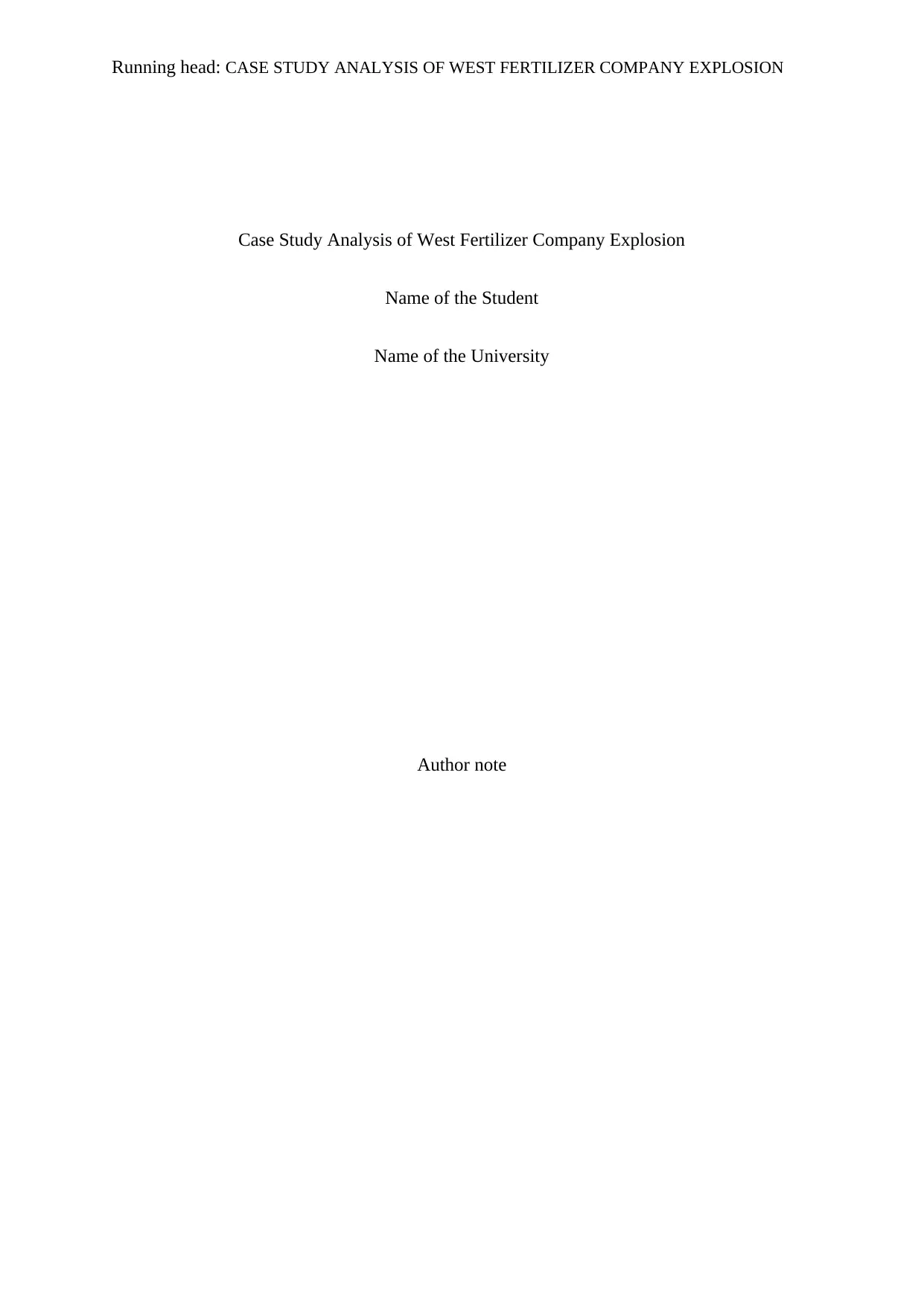
Running head: CASE STUDY ANALYSIS OF WEST FERTILIZER COMPANY EXPLOSION
Case Study Analysis of West Fertilizer Company Explosion
Name of the Student
Name of the University
Author note
Case Study Analysis of West Fertilizer Company Explosion
Name of the Student
Name of the University
Author note
Secure Best Marks with AI Grader
Need help grading? Try our AI Grader for instant feedback on your assignments.
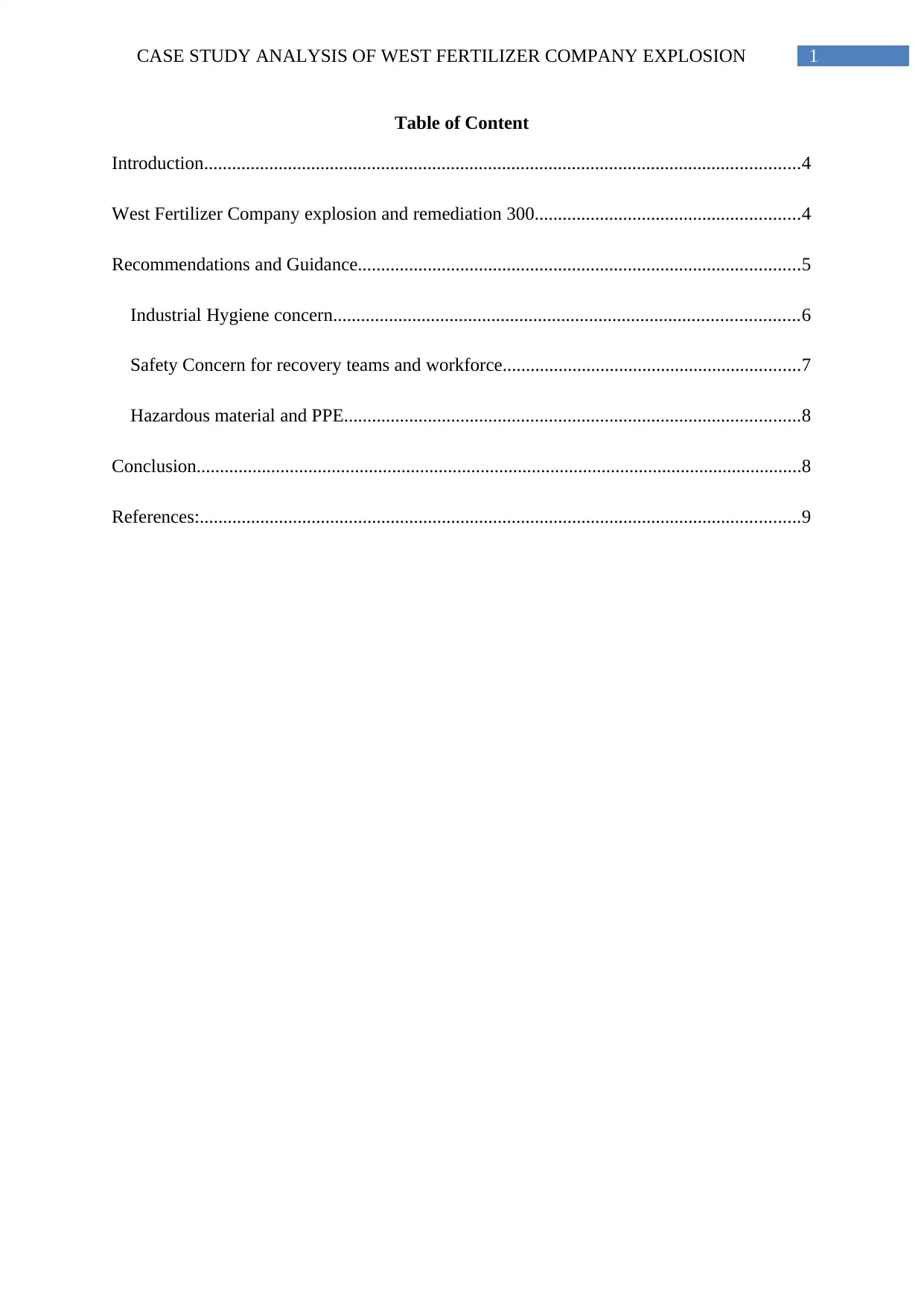
1CASE STUDY ANALYSIS OF WEST FERTILIZER COMPANY EXPLOSION
Table of Content
Introduction................................................................................................................................4
West Fertilizer Company explosion and remediation 300.........................................................4
Recommendations and Guidance...............................................................................................5
Industrial Hygiene concern....................................................................................................6
Safety Concern for recovery teams and workforce................................................................7
Hazardous material and PPE..................................................................................................8
Conclusion..................................................................................................................................8
References:.................................................................................................................................9
Table of Content
Introduction................................................................................................................................4
West Fertilizer Company explosion and remediation 300.........................................................4
Recommendations and Guidance...............................................................................................5
Industrial Hygiene concern....................................................................................................6
Safety Concern for recovery teams and workforce................................................................7
Hazardous material and PPE..................................................................................................8
Conclusion..................................................................................................................................8
References:.................................................................................................................................9
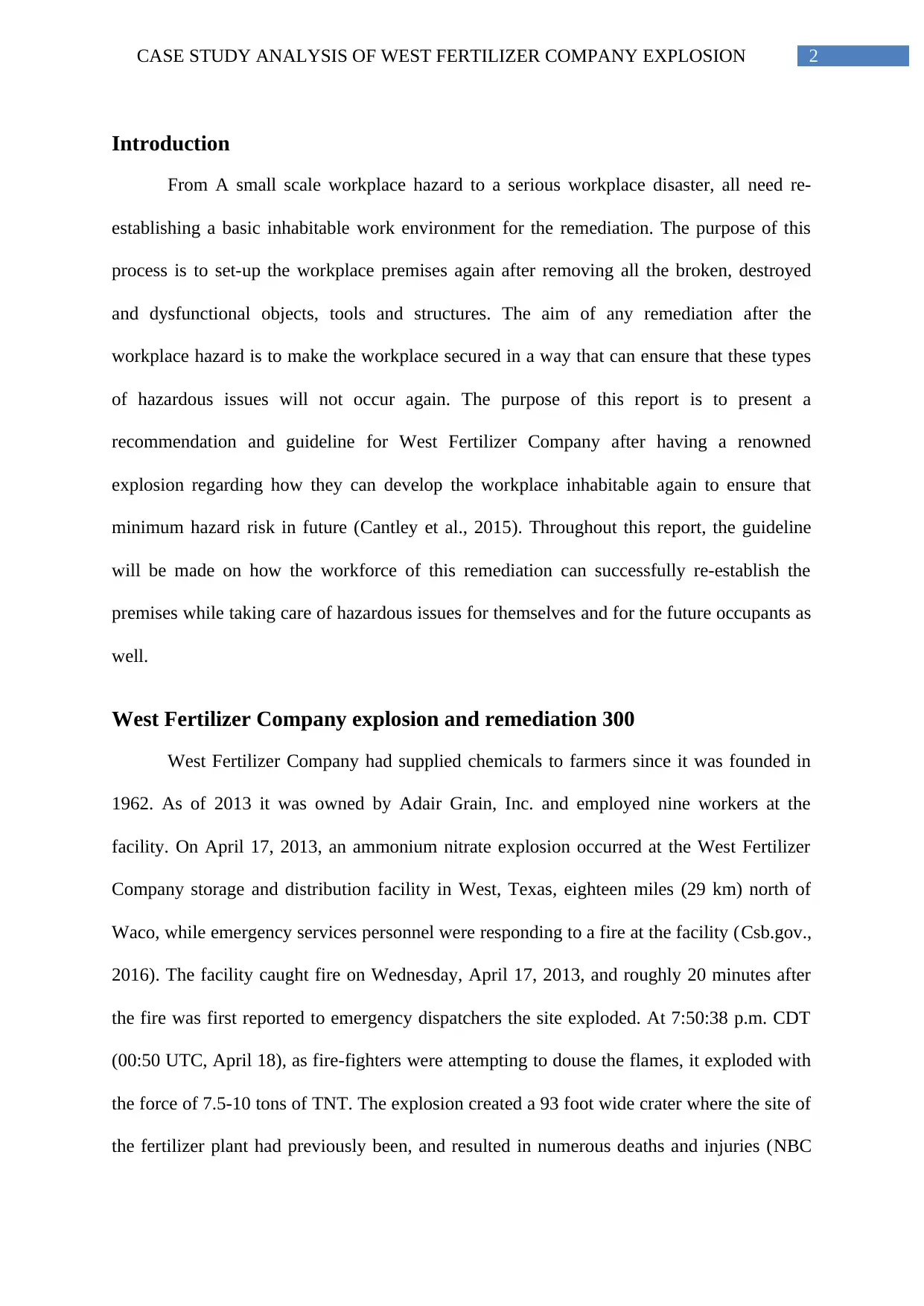
2CASE STUDY ANALYSIS OF WEST FERTILIZER COMPANY EXPLOSION
Introduction
From A small scale workplace hazard to a serious workplace disaster, all need re-
establishing a basic inhabitable work environment for the remediation. The purpose of this
process is to set-up the workplace premises again after removing all the broken, destroyed
and dysfunctional objects, tools and structures. The aim of any remediation after the
workplace hazard is to make the workplace secured in a way that can ensure that these types
of hazardous issues will not occur again. The purpose of this report is to present a
recommendation and guideline for West Fertilizer Company after having a renowned
explosion regarding how they can develop the workplace inhabitable again to ensure that
minimum hazard risk in future (Cantley et al., 2015). Throughout this report, the guideline
will be made on how the workforce of this remediation can successfully re-establish the
premises while taking care of hazardous issues for themselves and for the future occupants as
well.
West Fertilizer Company explosion and remediation 300
West Fertilizer Company had supplied chemicals to farmers since it was founded in
1962. As of 2013 it was owned by Adair Grain, Inc. and employed nine workers at the
facility. On April 17, 2013, an ammonium nitrate explosion occurred at the West Fertilizer
Company storage and distribution facility in West, Texas, eighteen miles (29 km) north of
Waco, while emergency services personnel were responding to a fire at the facility (Csb.gov.,
2016). The facility caught fire on Wednesday, April 17, 2013, and roughly 20 minutes after
the fire was first reported to emergency dispatchers the site exploded. At 7:50:38 p.m. CDT
(00:50 UTC, April 18), as fire-fighters were attempting to douse the flames, it exploded with
the force of 7.5-10 tons of TNT. The explosion created a 93 foot wide crater where the site of
the fertilizer plant had previously been, and resulted in numerous deaths and injuries (NBC
Introduction
From A small scale workplace hazard to a serious workplace disaster, all need re-
establishing a basic inhabitable work environment for the remediation. The purpose of this
process is to set-up the workplace premises again after removing all the broken, destroyed
and dysfunctional objects, tools and structures. The aim of any remediation after the
workplace hazard is to make the workplace secured in a way that can ensure that these types
of hazardous issues will not occur again. The purpose of this report is to present a
recommendation and guideline for West Fertilizer Company after having a renowned
explosion regarding how they can develop the workplace inhabitable again to ensure that
minimum hazard risk in future (Cantley et al., 2015). Throughout this report, the guideline
will be made on how the workforce of this remediation can successfully re-establish the
premises while taking care of hazardous issues for themselves and for the future occupants as
well.
West Fertilizer Company explosion and remediation 300
West Fertilizer Company had supplied chemicals to farmers since it was founded in
1962. As of 2013 it was owned by Adair Grain, Inc. and employed nine workers at the
facility. On April 17, 2013, an ammonium nitrate explosion occurred at the West Fertilizer
Company storage and distribution facility in West, Texas, eighteen miles (29 km) north of
Waco, while emergency services personnel were responding to a fire at the facility (Csb.gov.,
2016). The facility caught fire on Wednesday, April 17, 2013, and roughly 20 minutes after
the fire was first reported to emergency dispatchers the site exploded. At 7:50:38 p.m. CDT
(00:50 UTC, April 18), as fire-fighters were attempting to douse the flames, it exploded with
the force of 7.5-10 tons of TNT. The explosion created a 93 foot wide crater where the site of
the fertilizer plant had previously been, and resulted in numerous deaths and injuries (NBC
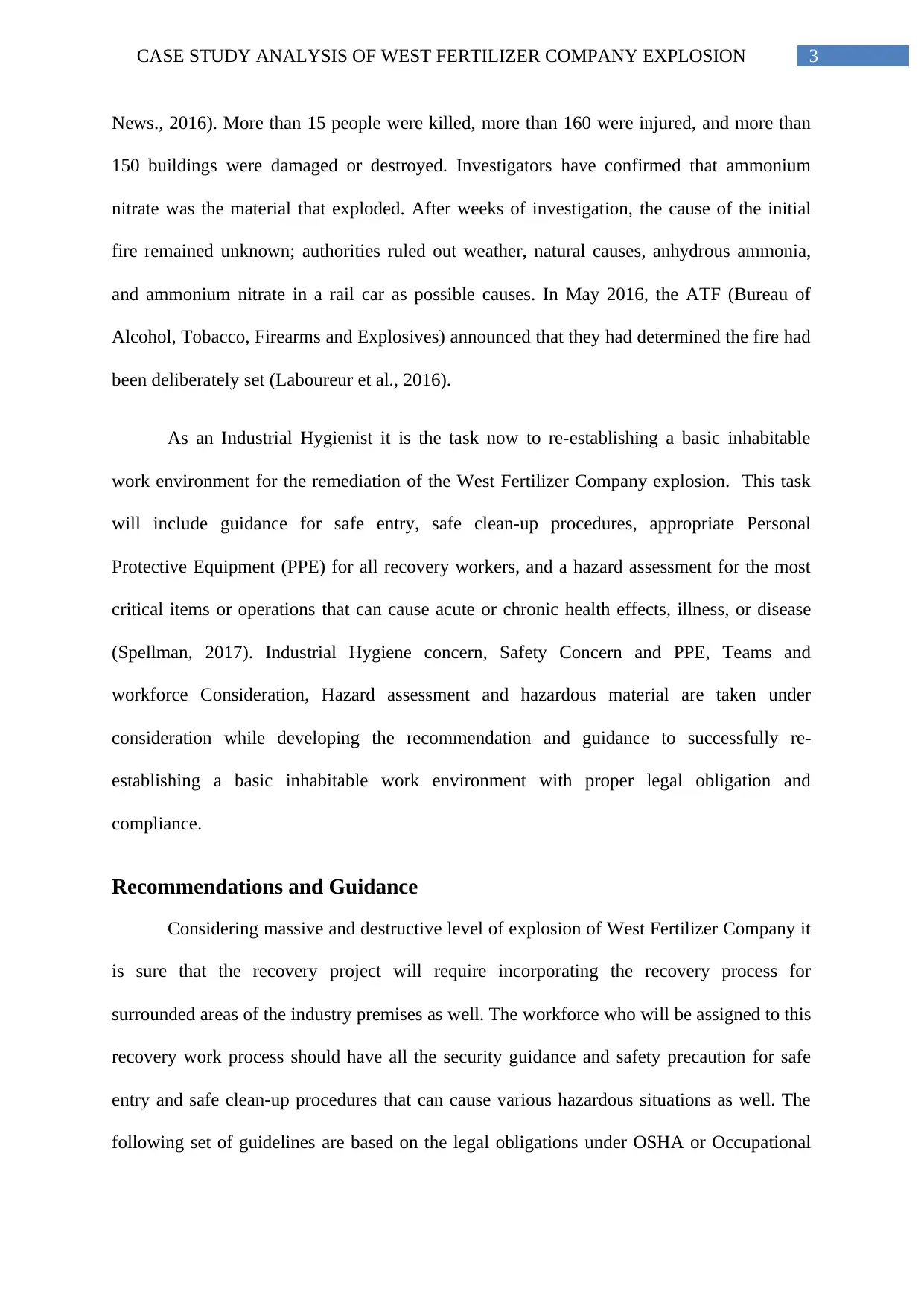
3CASE STUDY ANALYSIS OF WEST FERTILIZER COMPANY EXPLOSION
News., 2016). More than 15 people were killed, more than 160 were injured, and more than
150 buildings were damaged or destroyed. Investigators have confirmed that ammonium
nitrate was the material that exploded. After weeks of investigation, the cause of the initial
fire remained unknown; authorities ruled out weather, natural causes, anhydrous ammonia,
and ammonium nitrate in a rail car as possible causes. In May 2016, the ATF (Bureau of
Alcohol, Tobacco, Firearms and Explosives) announced that they had determined the fire had
been deliberately set (Laboureur et al., 2016).
As an Industrial Hygienist it is the task now to re-establishing a basic inhabitable
work environment for the remediation of the West Fertilizer Company explosion. This task
will include guidance for safe entry, safe clean-up procedures, appropriate Personal
Protective Equipment (PPE) for all recovery workers, and a hazard assessment for the most
critical items or operations that can cause acute or chronic health effects, illness, or disease
(Spellman, 2017). Industrial Hygiene concern, Safety Concern and PPE, Teams and
workforce Consideration, Hazard assessment and hazardous material are taken under
consideration while developing the recommendation and guidance to successfully re-
establishing a basic inhabitable work environment with proper legal obligation and
compliance.
Recommendations and Guidance
Considering massive and destructive level of explosion of West Fertilizer Company it
is sure that the recovery project will require incorporating the recovery process for
surrounded areas of the industry premises as well. The workforce who will be assigned to this
recovery work process should have all the security guidance and safety precaution for safe
entry and safe clean-up procedures that can cause various hazardous situations as well. The
following set of guidelines are based on the legal obligations under OSHA or Occupational
News., 2016). More than 15 people were killed, more than 160 were injured, and more than
150 buildings were damaged or destroyed. Investigators have confirmed that ammonium
nitrate was the material that exploded. After weeks of investigation, the cause of the initial
fire remained unknown; authorities ruled out weather, natural causes, anhydrous ammonia,
and ammonium nitrate in a rail car as possible causes. In May 2016, the ATF (Bureau of
Alcohol, Tobacco, Firearms and Explosives) announced that they had determined the fire had
been deliberately set (Laboureur et al., 2016).
As an Industrial Hygienist it is the task now to re-establishing a basic inhabitable
work environment for the remediation of the West Fertilizer Company explosion. This task
will include guidance for safe entry, safe clean-up procedures, appropriate Personal
Protective Equipment (PPE) for all recovery workers, and a hazard assessment for the most
critical items or operations that can cause acute or chronic health effects, illness, or disease
(Spellman, 2017). Industrial Hygiene concern, Safety Concern and PPE, Teams and
workforce Consideration, Hazard assessment and hazardous material are taken under
consideration while developing the recommendation and guidance to successfully re-
establishing a basic inhabitable work environment with proper legal obligation and
compliance.
Recommendations and Guidance
Considering massive and destructive level of explosion of West Fertilizer Company it
is sure that the recovery project will require incorporating the recovery process for
surrounded areas of the industry premises as well. The workforce who will be assigned to this
recovery work process should have all the security guidance and safety precaution for safe
entry and safe clean-up procedures that can cause various hazardous situations as well. The
following set of guidelines are based on the legal obligations under OSHA or Occupational
Secure Best Marks with AI Grader
Need help grading? Try our AI Grader for instant feedback on your assignments.
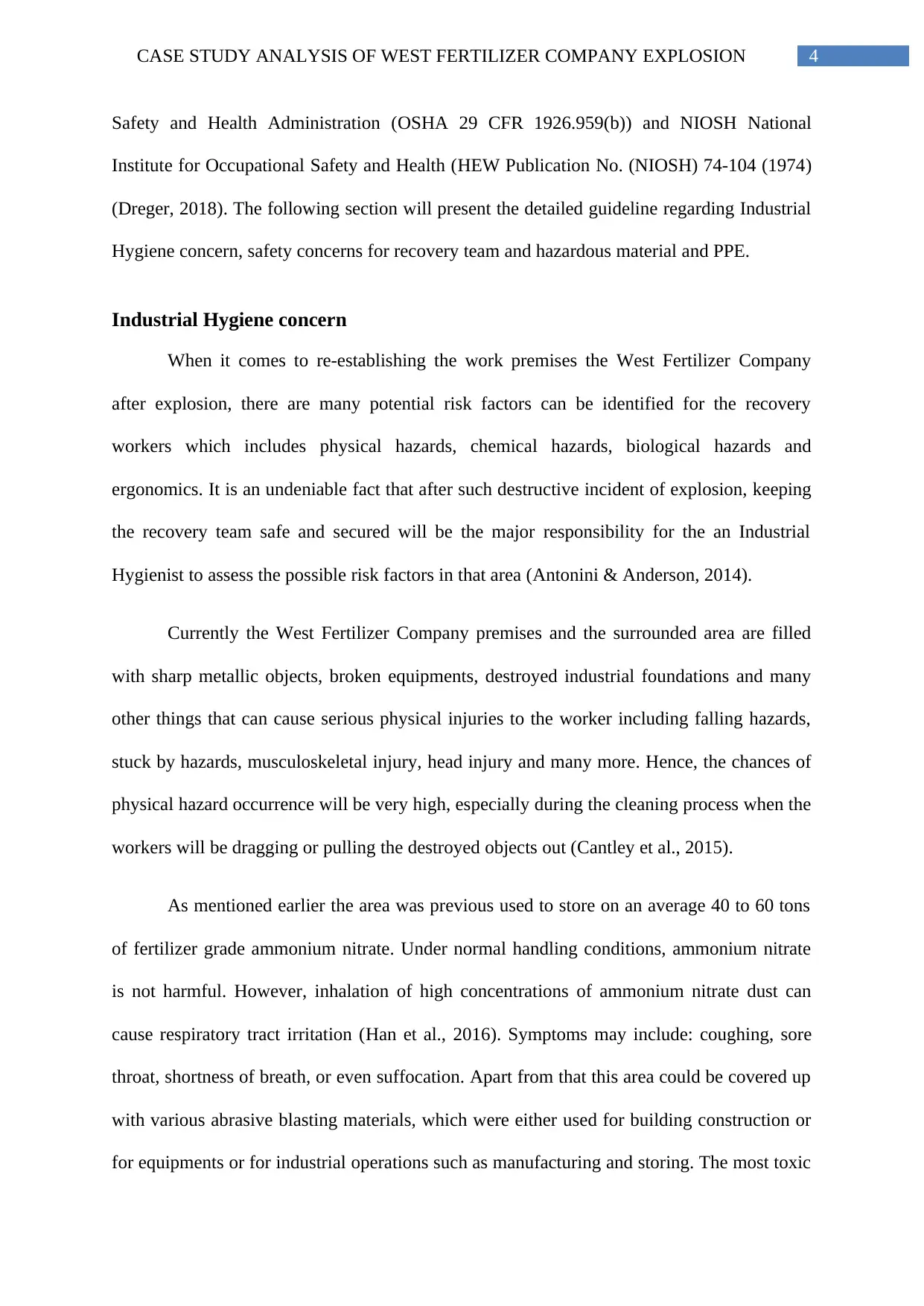
4CASE STUDY ANALYSIS OF WEST FERTILIZER COMPANY EXPLOSION
Safety and Health Administration (OSHA 29 CFR 1926.959(b)) and NIOSH National
Institute for Occupational Safety and Health (HEW Publication No. (NIOSH) 74-104 (1974)
(Dreger, 2018). The following section will present the detailed guideline regarding Industrial
Hygiene concern, safety concerns for recovery team and hazardous material and PPE.
Industrial Hygiene concern
When it comes to re-establishing the work premises the West Fertilizer Company
after explosion, there are many potential risk factors can be identified for the recovery
workers which includes physical hazards, chemical hazards, biological hazards and
ergonomics. It is an undeniable fact that after such destructive incident of explosion, keeping
the recovery team safe and secured will be the major responsibility for the an Industrial
Hygienist to assess the possible risk factors in that area (Antonini & Anderson, 2014).
Currently the West Fertilizer Company premises and the surrounded area are filled
with sharp metallic objects, broken equipments, destroyed industrial foundations and many
other things that can cause serious physical injuries to the worker including falling hazards,
stuck by hazards, musculoskeletal injury, head injury and many more. Hence, the chances of
physical hazard occurrence will be very high, especially during the cleaning process when the
workers will be dragging or pulling the destroyed objects out (Cantley et al., 2015).
As mentioned earlier the area was previous used to store on an average 40 to 60 tons
of fertilizer grade ammonium nitrate. Under normal handling conditions, ammonium nitrate
is not harmful. However, inhalation of high concentrations of ammonium nitrate dust can
cause respiratory tract irritation (Han et al., 2016). Symptoms may include: coughing, sore
throat, shortness of breath, or even suffocation. Apart from that this area could be covered up
with various abrasive blasting materials, which were either used for building construction or
for equipments or for industrial operations such as manufacturing and storing. The most toxic
Safety and Health Administration (OSHA 29 CFR 1926.959(b)) and NIOSH National
Institute for Occupational Safety and Health (HEW Publication No. (NIOSH) 74-104 (1974)
(Dreger, 2018). The following section will present the detailed guideline regarding Industrial
Hygiene concern, safety concerns for recovery team and hazardous material and PPE.
Industrial Hygiene concern
When it comes to re-establishing the work premises the West Fertilizer Company
after explosion, there are many potential risk factors can be identified for the recovery
workers which includes physical hazards, chemical hazards, biological hazards and
ergonomics. It is an undeniable fact that after such destructive incident of explosion, keeping
the recovery team safe and secured will be the major responsibility for the an Industrial
Hygienist to assess the possible risk factors in that area (Antonini & Anderson, 2014).
Currently the West Fertilizer Company premises and the surrounded area are filled
with sharp metallic objects, broken equipments, destroyed industrial foundations and many
other things that can cause serious physical injuries to the worker including falling hazards,
stuck by hazards, musculoskeletal injury, head injury and many more. Hence, the chances of
physical hazard occurrence will be very high, especially during the cleaning process when the
workers will be dragging or pulling the destroyed objects out (Cantley et al., 2015).
As mentioned earlier the area was previous used to store on an average 40 to 60 tons
of fertilizer grade ammonium nitrate. Under normal handling conditions, ammonium nitrate
is not harmful. However, inhalation of high concentrations of ammonium nitrate dust can
cause respiratory tract irritation (Han et al., 2016). Symptoms may include: coughing, sore
throat, shortness of breath, or even suffocation. Apart from that this area could be covered up
with various abrasive blasting materials, which were either used for building construction or
for equipments or for industrial operations such as manufacturing and storing. The most toxic
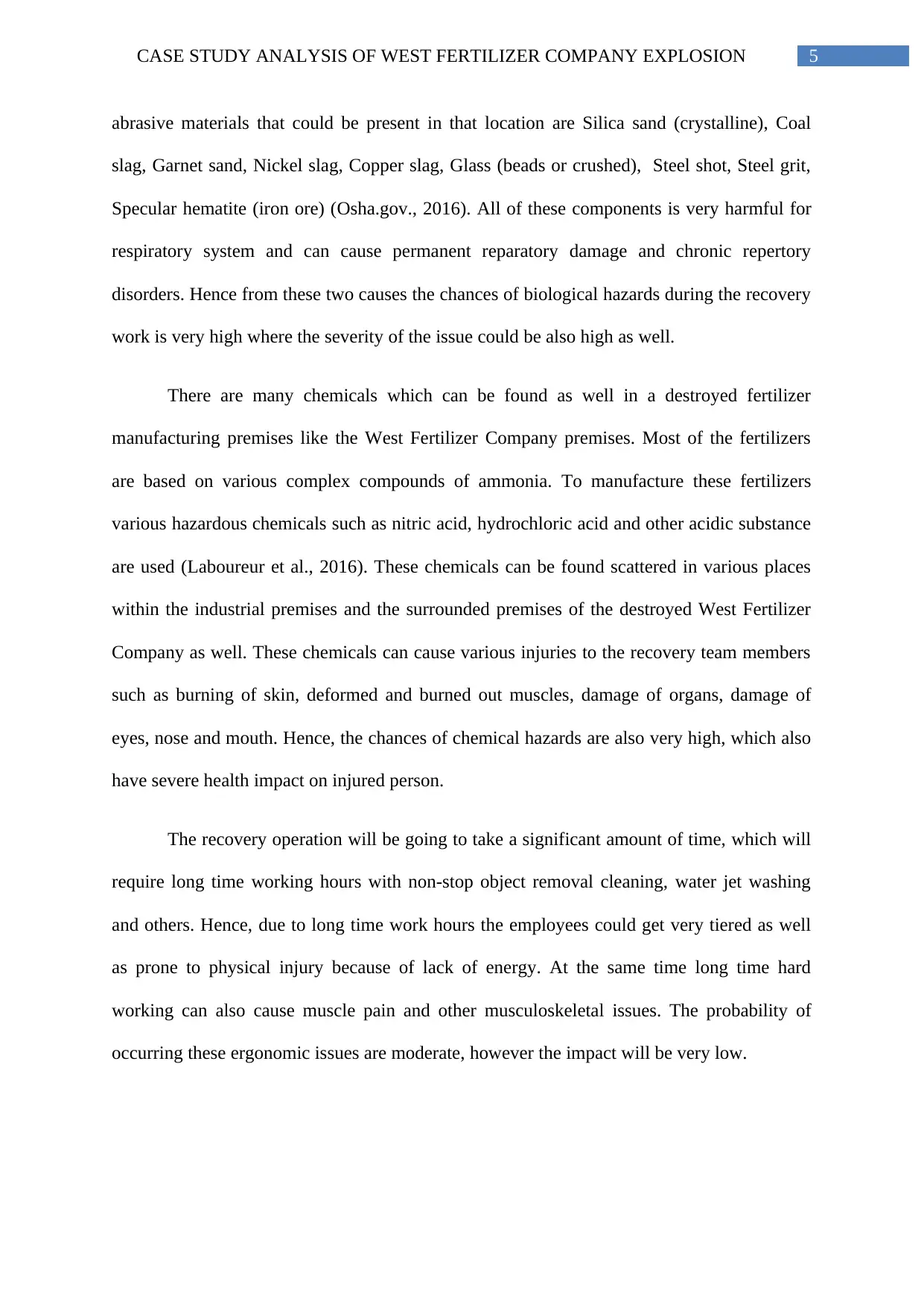
5CASE STUDY ANALYSIS OF WEST FERTILIZER COMPANY EXPLOSION
abrasive materials that could be present in that location are Silica sand (crystalline), Coal
slag, Garnet sand, Nickel slag, Copper slag, Glass (beads or crushed), Steel shot, Steel grit,
Specular hematite (iron ore) (Osha.gov., 2016). All of these components is very harmful for
respiratory system and can cause permanent reparatory damage and chronic repertory
disorders. Hence from these two causes the chances of biological hazards during the recovery
work is very high where the severity of the issue could be also high as well.
There are many chemicals which can be found as well in a destroyed fertilizer
manufacturing premises like the West Fertilizer Company premises. Most of the fertilizers
are based on various complex compounds of ammonia. To manufacture these fertilizers
various hazardous chemicals such as nitric acid, hydrochloric acid and other acidic substance
are used (Laboureur et al., 2016). These chemicals can be found scattered in various places
within the industrial premises and the surrounded premises of the destroyed West Fertilizer
Company as well. These chemicals can cause various injuries to the recovery team members
such as burning of skin, deformed and burned out muscles, damage of organs, damage of
eyes, nose and mouth. Hence, the chances of chemical hazards are also very high, which also
have severe health impact on injured person.
The recovery operation will be going to take a significant amount of time, which will
require long time working hours with non-stop object removal cleaning, water jet washing
and others. Hence, due to long time work hours the employees could get very tiered as well
as prone to physical injury because of lack of energy. At the same time long time hard
working can also cause muscle pain and other musculoskeletal issues. The probability of
occurring these ergonomic issues are moderate, however the impact will be very low.
abrasive materials that could be present in that location are Silica sand (crystalline), Coal
slag, Garnet sand, Nickel slag, Copper slag, Glass (beads or crushed), Steel shot, Steel grit,
Specular hematite (iron ore) (Osha.gov., 2016). All of these components is very harmful for
respiratory system and can cause permanent reparatory damage and chronic repertory
disorders. Hence from these two causes the chances of biological hazards during the recovery
work is very high where the severity of the issue could be also high as well.
There are many chemicals which can be found as well in a destroyed fertilizer
manufacturing premises like the West Fertilizer Company premises. Most of the fertilizers
are based on various complex compounds of ammonia. To manufacture these fertilizers
various hazardous chemicals such as nitric acid, hydrochloric acid and other acidic substance
are used (Laboureur et al., 2016). These chemicals can be found scattered in various places
within the industrial premises and the surrounded premises of the destroyed West Fertilizer
Company as well. These chemicals can cause various injuries to the recovery team members
such as burning of skin, deformed and burned out muscles, damage of organs, damage of
eyes, nose and mouth. Hence, the chances of chemical hazards are also very high, which also
have severe health impact on injured person.
The recovery operation will be going to take a significant amount of time, which will
require long time working hours with non-stop object removal cleaning, water jet washing
and others. Hence, due to long time work hours the employees could get very tiered as well
as prone to physical injury because of lack of energy. At the same time long time hard
working can also cause muscle pain and other musculoskeletal issues. The probability of
occurring these ergonomic issues are moderate, however the impact will be very low.
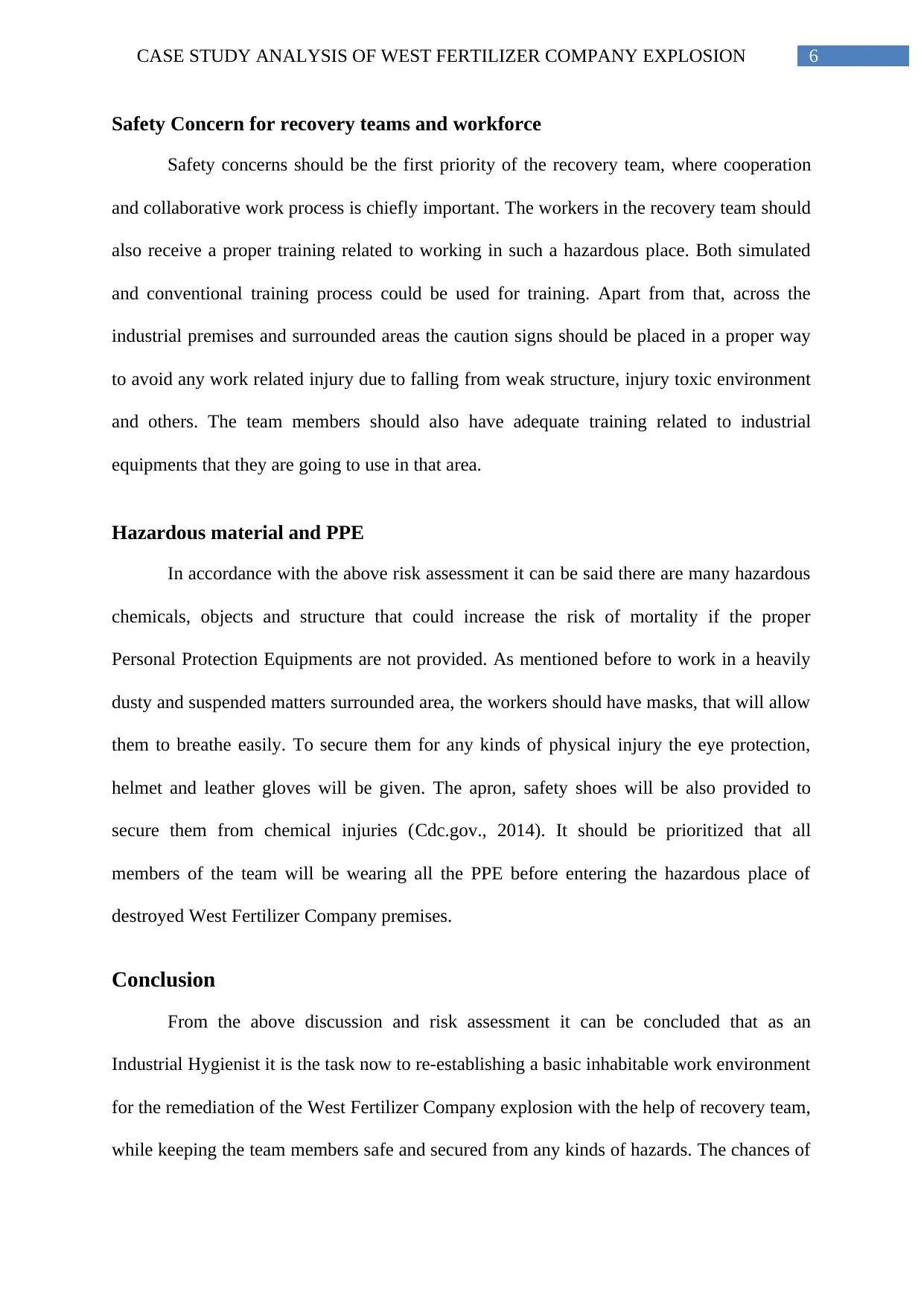
6CASE STUDY ANALYSIS OF WEST FERTILIZER COMPANY EXPLOSION
Safety Concern for recovery teams and workforce
Safety concerns should be the first priority of the recovery team, where cooperation
and collaborative work process is chiefly important. The workers in the recovery team should
also receive a proper training related to working in such a hazardous place. Both simulated
and conventional training process could be used for training. Apart from that, across the
industrial premises and surrounded areas the caution signs should be placed in a proper way
to avoid any work related injury due to falling from weak structure, injury toxic environment
and others. The team members should also have adequate training related to industrial
equipments that they are going to use in that area.
Hazardous material and PPE
In accordance with the above risk assessment it can be said there are many hazardous
chemicals, objects and structure that could increase the risk of mortality if the proper
Personal Protection Equipments are not provided. As mentioned before to work in a heavily
dusty and suspended matters surrounded area, the workers should have masks, that will allow
them to breathe easily. To secure them for any kinds of physical injury the eye protection,
helmet and leather gloves will be given. The apron, safety shoes will be also provided to
secure them from chemical injuries (Cdc.gov., 2014). It should be prioritized that all
members of the team will be wearing all the PPE before entering the hazardous place of
destroyed West Fertilizer Company premises.
Conclusion
From the above discussion and risk assessment it can be concluded that as an
Industrial Hygienist it is the task now to re-establishing a basic inhabitable work environment
for the remediation of the West Fertilizer Company explosion with the help of recovery team,
while keeping the team members safe and secured from any kinds of hazards. The chances of
Safety Concern for recovery teams and workforce
Safety concerns should be the first priority of the recovery team, where cooperation
and collaborative work process is chiefly important. The workers in the recovery team should
also receive a proper training related to working in such a hazardous place. Both simulated
and conventional training process could be used for training. Apart from that, across the
industrial premises and surrounded areas the caution signs should be placed in a proper way
to avoid any work related injury due to falling from weak structure, injury toxic environment
and others. The team members should also have adequate training related to industrial
equipments that they are going to use in that area.
Hazardous material and PPE
In accordance with the above risk assessment it can be said there are many hazardous
chemicals, objects and structure that could increase the risk of mortality if the proper
Personal Protection Equipments are not provided. As mentioned before to work in a heavily
dusty and suspended matters surrounded area, the workers should have masks, that will allow
them to breathe easily. To secure them for any kinds of physical injury the eye protection,
helmet and leather gloves will be given. The apron, safety shoes will be also provided to
secure them from chemical injuries (Cdc.gov., 2014). It should be prioritized that all
members of the team will be wearing all the PPE before entering the hazardous place of
destroyed West Fertilizer Company premises.
Conclusion
From the above discussion and risk assessment it can be concluded that as an
Industrial Hygienist it is the task now to re-establishing a basic inhabitable work environment
for the remediation of the West Fertilizer Company explosion with the help of recovery team,
while keeping the team members safe and secured from any kinds of hazards. The chances of
Paraphrase This Document
Need a fresh take? Get an instant paraphrase of this document with our AI Paraphraser
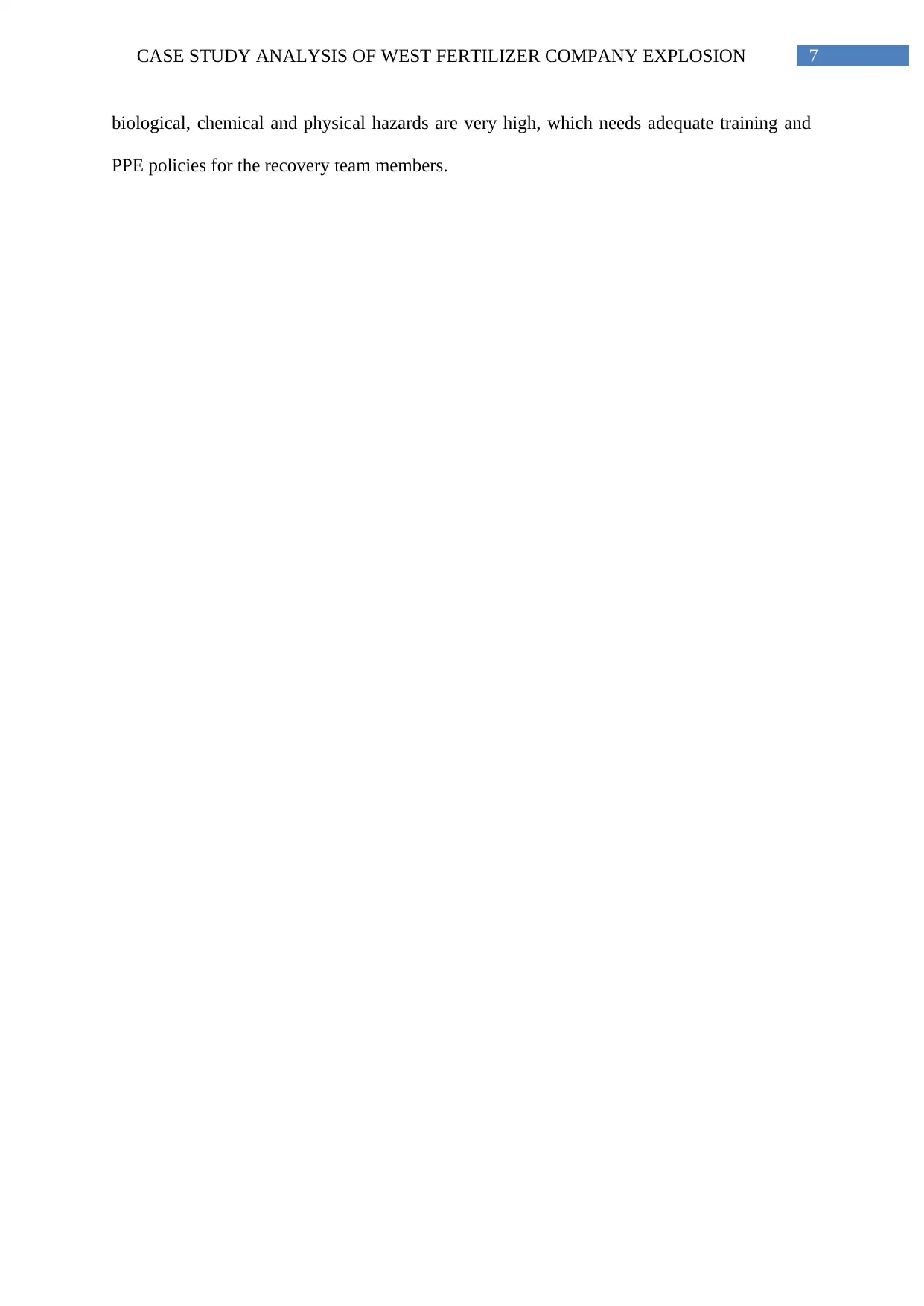
7CASE STUDY ANALYSIS OF WEST FERTILIZER COMPANY EXPLOSION
biological, chemical and physical hazards are very high, which needs adequate training and
PPE policies for the recovery team members.
biological, chemical and physical hazards are very high, which needs adequate training and
PPE policies for the recovery team members.
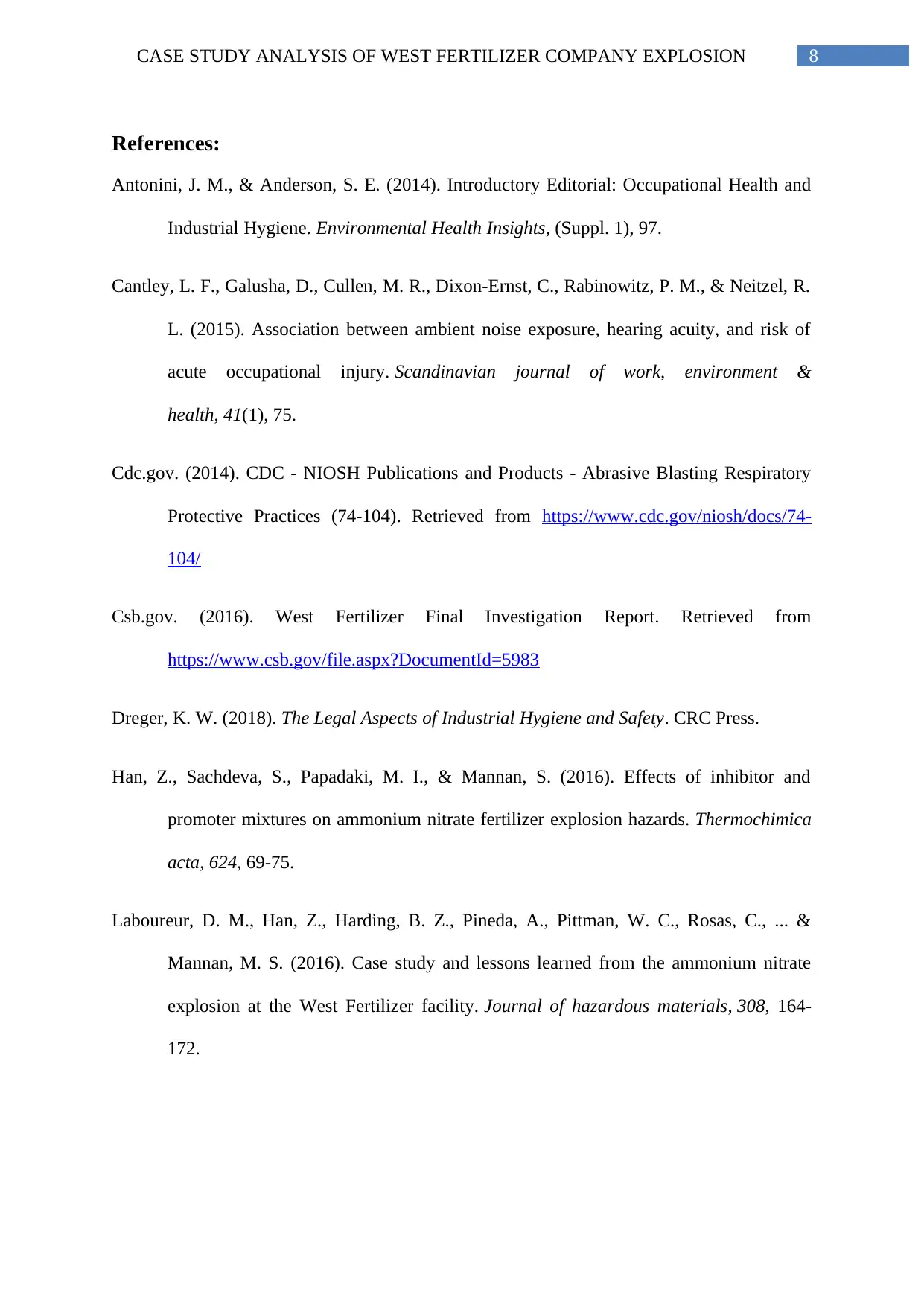
8CASE STUDY ANALYSIS OF WEST FERTILIZER COMPANY EXPLOSION
References:
Antonini, J. M., & Anderson, S. E. (2014). Introductory Editorial: Occupational Health and
Industrial Hygiene. Environmental Health Insights, (Suppl. 1), 97.
Cantley, L. F., Galusha, D., Cullen, M. R., Dixon-Ernst, C., Rabinowitz, P. M., & Neitzel, R.
L. (2015). Association between ambient noise exposure, hearing acuity, and risk of
acute occupational injury. Scandinavian journal of work, environment &
health, 41(1), 75.
Cdc.gov. (2014). CDC - NIOSH Publications and Products - Abrasive Blasting Respiratory
Protective Practices (74-104). Retrieved from https://www.cdc.gov/niosh/docs/74-
104/
Csb.gov. (2016). West Fertilizer Final Investigation Report. Retrieved from
https://www.csb.gov/file.aspx?DocumentId=5983
Dreger, K. W. (2018). The Legal Aspects of Industrial Hygiene and Safety. CRC Press.
Han, Z., Sachdeva, S., Papadaki, M. I., & Mannan, S. (2016). Effects of inhibitor and
promoter mixtures on ammonium nitrate fertilizer explosion hazards. Thermochimica
acta, 624, 69-75.
Laboureur, D. M., Han, Z., Harding, B. Z., Pineda, A., Pittman, W. C., Rosas, C., ... &
Mannan, M. S. (2016). Case study and lessons learned from the ammonium nitrate
explosion at the West Fertilizer facility. Journal of hazardous materials, 308, 164-
172.
References:
Antonini, J. M., & Anderson, S. E. (2014). Introductory Editorial: Occupational Health and
Industrial Hygiene. Environmental Health Insights, (Suppl. 1), 97.
Cantley, L. F., Galusha, D., Cullen, M. R., Dixon-Ernst, C., Rabinowitz, P. M., & Neitzel, R.
L. (2015). Association between ambient noise exposure, hearing acuity, and risk of
acute occupational injury. Scandinavian journal of work, environment &
health, 41(1), 75.
Cdc.gov. (2014). CDC - NIOSH Publications and Products - Abrasive Blasting Respiratory
Protective Practices (74-104). Retrieved from https://www.cdc.gov/niosh/docs/74-
104/
Csb.gov. (2016). West Fertilizer Final Investigation Report. Retrieved from
https://www.csb.gov/file.aspx?DocumentId=5983
Dreger, K. W. (2018). The Legal Aspects of Industrial Hygiene and Safety. CRC Press.
Han, Z., Sachdeva, S., Papadaki, M. I., & Mannan, S. (2016). Effects of inhibitor and
promoter mixtures on ammonium nitrate fertilizer explosion hazards. Thermochimica
acta, 624, 69-75.
Laboureur, D. M., Han, Z., Harding, B. Z., Pineda, A., Pittman, W. C., Rosas, C., ... &
Mannan, M. S. (2016). Case study and lessons learned from the ammonium nitrate
explosion at the West Fertilizer facility. Journal of hazardous materials, 308, 164-
172.
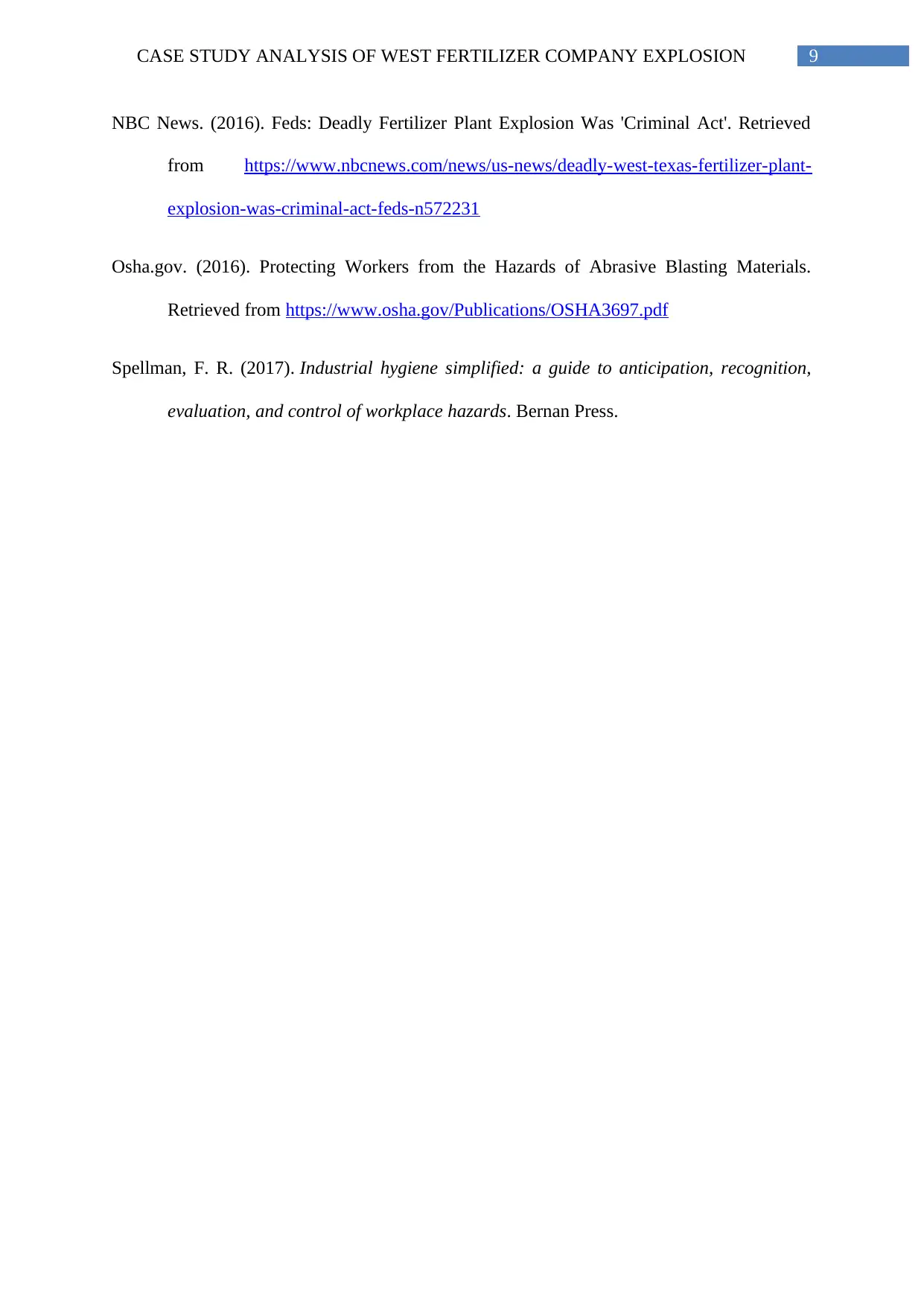
9CASE STUDY ANALYSIS OF WEST FERTILIZER COMPANY EXPLOSION
NBC News. (2016). Feds: Deadly Fertilizer Plant Explosion Was 'Criminal Act'. Retrieved
from https://www.nbcnews.com/news/us-news/deadly-west-texas-fertilizer-plant-
explosion-was-criminal-act-feds-n572231
Osha.gov. (2016). Protecting Workers from the Hazards of Abrasive Blasting Materials.
Retrieved from https://www.osha.gov/Publications/OSHA3697.pdf
Spellman, F. R. (2017). Industrial hygiene simplified: a guide to anticipation, recognition,
evaluation, and control of workplace hazards. Bernan Press.
NBC News. (2016). Feds: Deadly Fertilizer Plant Explosion Was 'Criminal Act'. Retrieved
from https://www.nbcnews.com/news/us-news/deadly-west-texas-fertilizer-plant-
explosion-was-criminal-act-feds-n572231
Osha.gov. (2016). Protecting Workers from the Hazards of Abrasive Blasting Materials.
Retrieved from https://www.osha.gov/Publications/OSHA3697.pdf
Spellman, F. R. (2017). Industrial hygiene simplified: a guide to anticipation, recognition,
evaluation, and control of workplace hazards. Bernan Press.
1 out of 10
Related Documents
Your All-in-One AI-Powered Toolkit for Academic Success.
+13062052269
info@desklib.com
Available 24*7 on WhatsApp / Email
![[object Object]](/_next/static/media/star-bottom.7253800d.svg)
Unlock your academic potential
© 2024 | Zucol Services PVT LTD | All rights reserved.




